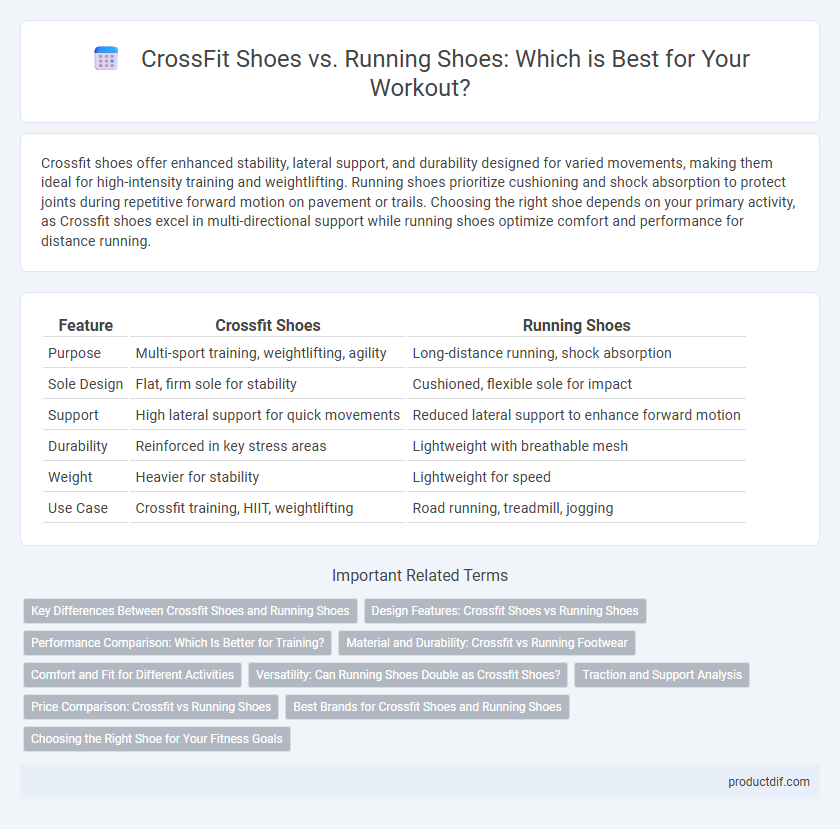Crossfit shoes offer enhanced stability, lateral support, and durability designed for varied movements, making them ideal for high-intensity training and weightlifting. Running shoes prioritize cushioning and shock absorption to protect joints during repetitive forward motion on pavement or trails. Choosing the right shoe depends on your primary activity, as Crossfit shoes excel in multi-directional support while running shoes optimize comfort and performance for distance running.
Table of Comparison
| Feature | Crossfit Shoes | Running Shoes |
|---|---|---|
| Purpose | Multi-sport training, weightlifting, agility | Long-distance running, shock absorption |
| Sole Design | Flat, firm sole for stability | Cushioned, flexible sole for impact |
| Support | High lateral support for quick movements | Reduced lateral support to enhance forward motion |
| Durability | Reinforced in key stress areas | Lightweight with breathable mesh |
| Weight | Heavier for stability | Lightweight for speed |
| Use Case | Crossfit training, HIIT, weightlifting | Road running, treadmill, jogging |
Key Differences Between Crossfit Shoes and Running Shoes
Crossfit shoes feature a flat, stable sole designed for weightlifting and multidirectional movements, while running shoes prioritize cushioning and shock absorption for forward motion. Crossfit shoes typically have reinforced toe boxes and durable uppers for rope climbs and high-impact training, whereas running shoes are lighter and more flexible to enhance stride efficiency. The key difference lies in Crossfit shoes' support for versatile gym activities versus running shoes' specialization in long-distance running comfort.
Design Features: Crossfit Shoes vs Running Shoes
Crossfit shoes feature a flat, durable sole with enhanced lateral support and reinforced toe areas to withstand varied movements like jumping, lifting, and lateral shifts. Running shoes prioritize cushioning and shock absorption with curved soles designed to promote forward motion and reduce impact on joints. The distinct design features cater to the specific biomechanics and intensity of Crossfit training versus running activities.
Performance Comparison: Which Is Better for Training?
CrossFit shoes offer superior lateral support, enhanced grip, and durability designed for high-intensity, multi-directional movements, making them ideal for various training modalities such as weightlifting and jumping. Running shoes prioritize cushioning, shock absorption, and forward propulsion efficiency, improving endurance and minimizing impact during long-distance runs. Choosing the best footwear depends on the primary activity; CrossFit shoes optimize functional fitness performance, while running shoes excel in providing comfort and protection for sustained running sessions.
Material and Durability: Crossfit vs Running Footwear
Crossfit shoes typically use reinforced synthetic materials and rubber outsoles designed to withstand high-intensity movements and heavy lifting, providing increased durability and support during lateral motions. Running shoes prioritize lightweight, breathable mesh fabrics combined with cushioned midsoles to enhance comfort and shock absorption over repetitive forward strides, though they may wear out faster under multidirectional stress. The material composition and construction of Crossfit shoes generally offer superior durability for versatile training compared to the specialized cushioning and flexibility found in running shoes.
Comfort and Fit for Different Activities
Crossfit shoes provide a stable, supportive fit designed for multidirectional movements, ideal for weightlifting, jumping, and varied gym exercises, enhancing overall comfort during high-intensity training. Running shoes prioritize cushioning and shock absorption with a lightweight, flexible design optimized for forward motion, ensuring comfort during long-distance runs. Selecting shoes tailored to your specific activity significantly improves fit, reduces injury risk, and maximizes performance.
Versatility: Can Running Shoes Double as Crossfit Shoes?
Running shoes offer superior cushioning and flexibility for forward motion but lack the lateral support and durability needed for CrossFit's multidirectional movements. CrossFit shoes are designed with reinforced soles and stability features to handle weightlifting, jumping, and quick direction changes effectively. While running shoes can be used for light CrossFit workouts, they do not provide the comprehensive support and resilience required for intense training sessions.
Traction and Support Analysis
Crossfit shoes offer superior traction with multidirectional grip patterns designed for varied gym activities, providing stability during lateral movements and quick transitions. Running shoes prioritize forward motion traction, featuring cushioned soles that enhance shock absorption but offer less grip for lateral support. Support in Crossfit shoes emphasizes ankle and midfoot stability to prevent injuries during high-impact lifts, whereas running shoes focus on arch support and heel cushioning to optimize forward propulsion and reduce overpronation.
Price Comparison: Crossfit vs Running Shoes
Crossfit shoes typically range from $100 to $160, offering enhanced durability and multi-directional support designed for varied workouts, while running shoes generally cost between $80 and $150, prioritizing cushioning and shock absorption for forward motion. The price difference reflects the specialized construction of Crossfit shoes, often incorporating reinforced soles and stability features that elevate manufacturing costs. Consumers should consider their specific athletic needs and budget, as running shoes are more affordable for endurance training, whereas Crossfit shoes justify the higher price through versatility and robust design.
Best Brands for Crossfit Shoes and Running Shoes
Nike and Reebok are top contenders in the best brands for Crossfit shoes, offering durable designs with enhanced grip and stability ideal for high-intensity training. For running shoes, brands like Asics, Brooks, and New Balance lead with advanced cushioning and biomechanics support tailored for long-distance performance. Choosing between these categories depends on training needs, with Crossfit shoes prioritizing multi-directional support and running shoes emphasizing shock absorption and forward motion efficiency.
Choosing the Right Shoe for Your Fitness Goals
Crossfit shoes provide enhanced stability, lateral support, and durability essential for high-intensity training, weightlifting, and varied movements, whereas running shoes prioritize cushioning and shock absorption optimized for forward motion. Selecting the right shoe hinges on your primary activity; Crossfit shoes improve performance and reduce injury risk during dynamic workouts, while running shoes enhance comfort and efficiency for long-distance running. Evaluating your fitness goals and workout style ensures optimal footwear choice, maximizing both effectiveness and foot health.
Crossfit Shoes vs Running Shoes Infographic

 productdif.com
productdif.com